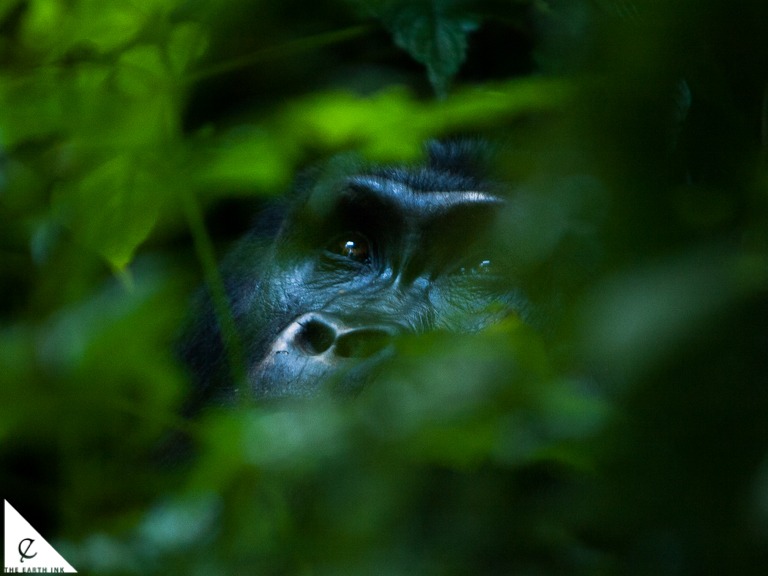Bwindi Impenetrable Forest, Uganda
I never expected to witness a woman desperately throwing her hand into a fresh, mushy pile of gorilla poo. She unceremoniously grabbed into the brown sludge to balance herself while ascending a hill of leafy green foliage while attempting to keep up with a family of gorillas and make the most of our allotted one hour with them in their natural environment.
As Bwindi Impenetrable National Park's name suggests, the tangled thicket of trees, bushes, and green ground coverings on the steep, damp, fertilised hills of the Forest remain impenetrable in places. Our merciful porters assisted our group of eight through the Forest—carrying our bags, holding our hands, and occasionally lifting members of our group across slippery spots, while AK-47 armed military and police guides tramped ahead and behind to guard us all against a highly unusual, but not impossible forest elephant encounter. Diverting off the main trail, our gorilla trekking guide bushwhacked the mass of vines and branches from our path with a machete in search of the beautiful creatures. However, even all the support, navigation, and safety personnel surrounding our group could not anticipate or prevent the poo-grabbing incident.
We located our gorilla family, the Habinyanja family, in 38 minutes–a relatively short hike considering some have to hike more than 4-6 hours to catch up to the constantly migrating animals. Mountain gorillas make new nests each night–spending their days on the move looking for food.
Currently home to 53% of the world's mountain gorillas, the country of Uganda only allots ten families to be tracked for tourists to observe. Eighty permits are issued each day at a cost of $600 per person with much of that fee going back gorilla protection efforts and to local community infrastructure and special project funding. In the region of Bwindi, townspeople benefit from both the park fees and the presence of tourists who visit and support local organisations like Ride 4 a Woman, the Batwa Pygmy people, and the beautiful new Uganda Nursing School Bwindi.
With a seven meter distance between human and gorilla species, the ten tracked gorilla families are modestly familiar with humans and the shutter click of cameras. Due to the genetic similarities between humans and gorillas, a closer proximity can encourage a breeding ground for communicable diseases. Remarkably, gorillas are able to treat themselves for common illnesses with plants found in the Forest—like using wild ginger as an aid for stomach troubles just as humans might drink ginger tea.
On the day of our visit, the Habinyanja's were on the move. Maraya, the male scout or navigator aggressively plays the number two roll in the family finding new foraging grounds; but Makara, the dominant male silverback, led the family up a steep hill while our tracking group pursued at a distance. Our porters abandoned us to observe the gorillas on our own—which meant we had to negotiate the Forest with our own two feet and hands. A New York-based woman, quite gracefully slipped and rolled into the bushy ground covering and down the hill prompting uncontrollable laughter by the rest of the human group. She clearly intended to enjoy the soft plants as much as the gorilla children we witnessed in front of us.
The poo-grabber, from Victoria, Canada, used vines to balance herself and quickly pull her body up an embankment when she found the feces. She privately wiped her hand on the leaves nearby and slid her palm on her pants to rid her skin of the rest whispering back to me, "These pants will not be coming home with me." I suggested that she might want to change her mind. They would make a great souvenir–afterall, how many people can say they have pants with gorilla poo on them?
*Andrea enjoyed a Gorilla Tracking adventure while part of the media delegation in attendance at the Africa Travel Association's 39th Annual World Congress in Kampala, Uganda. The trip was sponsored, this story is not.
© 2014 Andrea Rip | The Earth Ink. All Rights Reserved Unless Specified.
For reuse or press enquiries: theearthink@gmail.com.
As Bwindi Impenetrable National Park's name suggests, the tangled thicket of trees, bushes, and green ground coverings on the steep, damp, fertilised hills of the Forest remain impenetrable in places. Our merciful porters assisted our group of eight through the Forest—carrying our bags, holding our hands, and occasionally lifting members of our group across slippery spots, while AK-47 armed military and police guides tramped ahead and behind to guard us all against a highly unusual, but not impossible forest elephant encounter. Diverting off the main trail, our gorilla trekking guide bushwhacked the mass of vines and branches from our path with a machete in search of the beautiful creatures. However, even all the support, navigation, and safety personnel surrounding our group could not anticipate or prevent the poo-grabbing incident.
We located our gorilla family, the Habinyanja family, in 38 minutes–a relatively short hike considering some have to hike more than 4-6 hours to catch up to the constantly migrating animals. Mountain gorillas make new nests each night–spending their days on the move looking for food.
Currently home to 53% of the world's mountain gorillas, the country of Uganda only allots ten families to be tracked for tourists to observe. Eighty permits are issued each day at a cost of $600 per person with much of that fee going back gorilla protection efforts and to local community infrastructure and special project funding. In the region of Bwindi, townspeople benefit from both the park fees and the presence of tourists who visit and support local organisations like Ride 4 a Woman, the Batwa Pygmy people, and the beautiful new Uganda Nursing School Bwindi.
With a seven meter distance between human and gorilla species, the ten tracked gorilla families are modestly familiar with humans and the shutter click of cameras. Due to the genetic similarities between humans and gorillas, a closer proximity can encourage a breeding ground for communicable diseases. Remarkably, gorillas are able to treat themselves for common illnesses with plants found in the Forest—like using wild ginger as an aid for stomach troubles just as humans might drink ginger tea.
On the day of our visit, the Habinyanja's were on the move. Maraya, the male scout or navigator aggressively plays the number two roll in the family finding new foraging grounds; but Makara, the dominant male silverback, led the family up a steep hill while our tracking group pursued at a distance. Our porters abandoned us to observe the gorillas on our own—which meant we had to negotiate the Forest with our own two feet and hands. A New York-based woman, quite gracefully slipped and rolled into the bushy ground covering and down the hill prompting uncontrollable laughter by the rest of the human group. She clearly intended to enjoy the soft plants as much as the gorilla children we witnessed in front of us.
The poo-grabber, from Victoria, Canada, used vines to balance herself and quickly pull her body up an embankment when she found the feces. She privately wiped her hand on the leaves nearby and slid her palm on her pants to rid her skin of the rest whispering back to me, "These pants will not be coming home with me." I suggested that she might want to change her mind. They would make a great souvenir–afterall, how many people can say they have pants with gorilla poo on them?
*Andrea enjoyed a Gorilla Tracking adventure while part of the media delegation in attendance at the Africa Travel Association's 39th Annual World Congress in Kampala, Uganda. The trip was sponsored, this story is not.
© 2014 Andrea Rip | The Earth Ink. All Rights Reserved Unless Specified.
For reuse or press enquiries: theearthink@gmail.com.




Comments